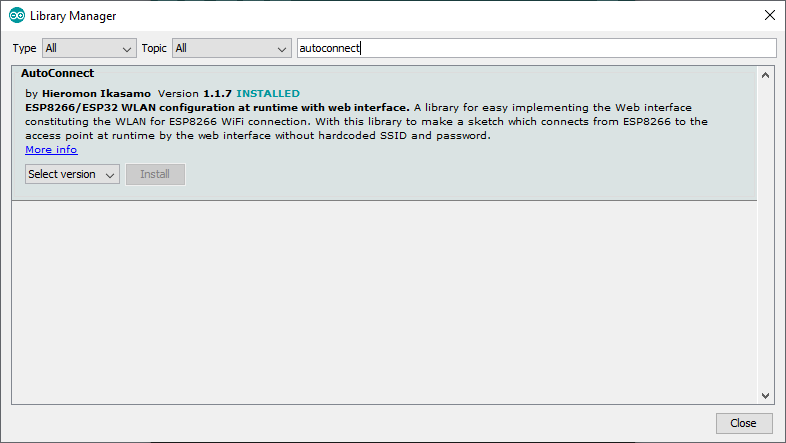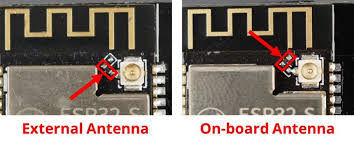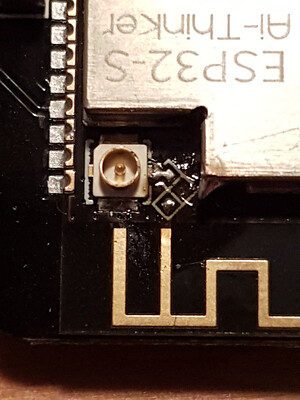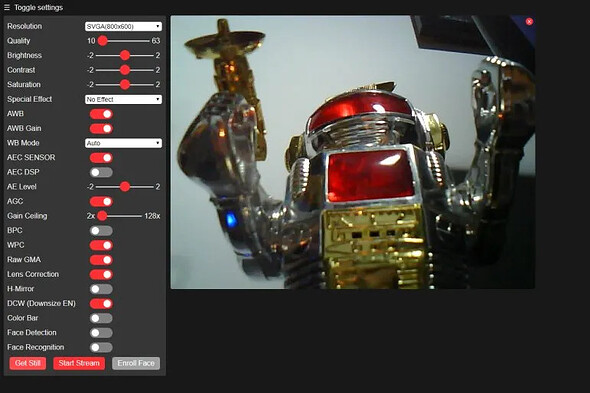Bonjour
Après pas mal de recherches, j’ai réussi à intégrer la gestion de la LED via des requêtes HTTP.
J’ai gardé le code actuel, sur lequel j’ai rajouté la LED via le asyncwebserver. Voici le code:
// SERVEUR WEB CAM From: https://community.jeedom.com/t/tuto-camera-a-focale-fixe-basee-sur-esp32/17587/49
// LED WIFI FROM: https://techtutorialsx.com/2018/02/03/esp32-arduino-async-server-controlling-http-methods-allowed/
// For installing Asyncwebserver: https://techtutorialsx.com/2017/12/01/esp32-arduino-asynchronous-http-webserver/
// modified by DRS - May 2020
//
//
#include <WiFi.h>
#include <WebServer.h>
#include <ESPAsyncWebServer.h> //permet la connexion simultanee pour la gestion de la LED
#include <WiFiClient.h>
#include <AutoConnect.h> // Needs AutoConnect, PageBuilder libraries!
#include "soc/soc.h" //disable brownout problems
#include "soc/rtc_cntl_reg.h" //disable brownout problems
#define ENABLE_RTSPSERVER
#define ENABLE_WEBSERVER
#define RESOLUTION FRAMESIZE_XGA // FRAMESIZE_ + QVGA|CIF|VGA|SVGA|XGA|SXGA|UXGA
#define QUALITY 10 // JPEG quality 10-63 (lower means better quality)
#define PIN_FLASH_LED -1 // GPIO4 for AIThinker module, set to -1 if not needed!
#define LED_BUILTIN 4 // VA SERVIR POUR ALLUMER et ETEINDRE LA LED
#include "OV2640.h"
#ifdef ENABLE_RTSPSERVER
#include "OV2640Streamer.h"
#include "CRtspSession.h"
#endif
OV2640 cam;
boolean useRTSP = true;
WebServer server(80);
AsyncWebServer serverasync(81);
AutoConnect Portal(server);
AutoConnectConfig acConfig;
#ifdef ENABLE_RTSPSERVER
WiFiServer rtspServer(554);
CStreamer *streamer;
#endif
void setflash(byte state) {
if (PIN_FLASH_LED>-1){
digitalWrite(PIN_FLASH_LED, state);
}
}
void handle_jpg_stream(void)
{
WiFiClient client = server.client();
String response = "HTTP/1.1 200 OK\r\n";
response += "Content-Type: multipart/x-mixed-replace; boundary=frame\r\n\r\n";
server.sendContent(response);
while (1)
{
cam.run();
if (!client.connected())
break;
response = "--frame\r\n";
response += "Content-Type: image/jpeg\r\n\r\n";
server.sendContent(response);
client.write((char *)cam.getfb(), cam.getSize());
server.sendContent("\r\n");
if (!client.connected())
break;
}
}
void handle_jpg(void)
{
setflash(1);
WiFiClient client = server.client();
cam.run();
if (!client.connected())
{
return;
}
String response = "HTTP/1.1 200 OK\r\n";
response += "Content-disposition: inline; filename=snapshot.jpg\r\n";
response += "Content-type: image/jpeg\r\n\r\n";
server.sendContent(response);
client.write((char *)cam.getfb(), cam.getSize());
setflash(0);
}
void handle_root(void)
{
String reply = F("<!doctype html><html><H1>ESP32CAM</H1>");
reply += F("<p>Resolution: ");
switch(RESOLUTION) {
case FRAMESIZE_QVGA:
reply += F("QVGA (320x240)");
break;
case FRAMESIZE_CIF:
reply += F("CIF (400x296)");
break;
case FRAMESIZE_VGA:
reply += F("VGA (640x480)");
break;
case FRAMESIZE_SVGA:
reply += F("SVGA (800x600)");
break;
case FRAMESIZE_XGA:
reply += F("XGA (1024x768)");
break;
case FRAMESIZE_SXGA:
reply += F("SXGA (1280x1024)");
break;
case FRAMESIZE_UXGA:
reply += F("UXGA (1600x1200)");
break;
default:
reply += F("Unknown");
break;
}
reply += F("<p>PSRAM found: ");
if (psramFound()){
reply += F("TRUE");
} else {
reply += F("FALSE");
}
String url = "http://" + WiFi.localIP().toString() + "/snapshot.jpg";
reply += "<p>Snapshot URL:<br> <a href='" + url + "'>" + url + "</a>";
url = "http://" + WiFi.localIP().toString() + "/mjpg";
reply += "<p>HTTP MJPEG URL:<br> <a href='" + url + "'>" + url + "</a>";
url = "rtsp://" + WiFi.localIP().toString() + ":554/mjpeg/1";
reply += "<p>RTSP MJPEG URL:<br> " + url;
url = "http://" + WiFi.localIP().toString() + "/_ac";
reply += "<p>WiFi settings page:<br> <a href='" + url + "'>" + url + "</a>";
reply += F("</body></html>");
server.send(200, "text/html", reply);
}
void handleNotFound()
{
String message = "Server is running!\n\n";
message += "URI: ";
message += server.uri();
message += "\nMethod: ";
message += (server.method() == HTTP_GET) ? "GET" : "POST";
message += "\nArguments: ";
message += server.args();
message += "\n";
server.send(200, "text/plain", message);
}
void setup(){
pinMode(LED_BUILTIN, OUTPUT); // pour LED
digitalWrite(LED_BUILTIN, LOW); // pour LED
WRITE_PERI_REG(RTC_CNTL_BROWN_OUT_REG, 0); //disable brownout detector
Serial.begin(115200);
// while (!Serial){;} // debug only
camera_config_t cconfig;
cconfig = esp32cam_aithinker_config;
if (psramFound()) {
cconfig.frame_size = RESOLUTION; // FRAMESIZE_ + QVGA|CIF|VGA|SVGA|XGA|SXGA|UXGA
cconfig.jpeg_quality = QUALITY;
cconfig.fb_count = 2;
} else {
if (RESOLUTION>FRAMESIZE_SVGA) {
cconfig.frame_size = FRAMESIZE_SVGA;
}
cconfig.jpeg_quality = 12;
cconfig.fb_count = 1;
}
if (PIN_FLASH_LED>-1){
pinMode(PIN_FLASH_LED, OUTPUT);
setflash(0);
}
cam.init(cconfig);
server.on("/", handle_root);
server.on("/mjpg", HTTP_GET, handle_jpg_stream);
server.on("/snapshot.jpg", HTTP_GET, handle_jpg);
Portal.onNotFound(handleNotFound);
acConfig.apid = "ESP-" + String((uint32_t)(ESP.getEfuseMac() >> 32), HEX);
acConfig.psk = "configesp";
// acConfig.apip = IPAddress(192,168,4,1);
acConfig.hostName = acConfig.apid;
acConfig.autoReconnect = true;
Portal.config(acConfig);
Portal.begin();
// POUR LED
serverasync.on("/relay/off", HTTP_ANY, [](AsyncWebServerRequest *request){
request->send(200, "text/plain", "ok");
digitalWrite(LED_BUILTIN, LOW);
});
serverasync.on("/relay/on", HTTP_ANY, [](AsyncWebServerRequest *request){
request->send(200, "text/plain","ok");
digitalWrite(LED_BUILTIN, HIGH);
});
serverasync.on("/relay/toggle", HTTP_ANY, [](AsyncWebServerRequest *request){
request->send(200, "text/plain","ok");
digitalWrite(LED_BUILTIN, !digitalRead(LED_BUILTIN));
});
serverasync.on("/relay", HTTP_GET, [](AsyncWebServerRequest *request){
request->send(200, "text/plain", String(digitalRead(LED_BUILTIN)));
});
serverasync.begin();
//
#ifdef ENABLE_RTSPSERVER
if (useRTSP) {
rtspServer.begin();
streamer = new OV2640Streamer(cam); // our streamer for UDP/TCP based RTP transport
}
#endif
}
void loop()
{
//server.handleClient();
Portal.handleClient();
#ifdef ENABLE_RTSPSERVER
if (useRTSP) {
uint32_t msecPerFrame = 100;
static uint32_t lastimage = millis();
// If we have an active client connection, just service that until gone
streamer->handleRequests(0); // we don't use a timeout here,
// instead we send only if we have new enough frames
uint32_t now = millis();
if (streamer->anySessions()) {
if (now > lastimage + msecPerFrame || now < lastimage) { // handle clock rollover
streamer->streamImage(now);
lastimage = now;
// check if we are overrunning our max frame rate
now = millis();
if (now > lastimage + msecPerFrame) {
printf("warning exceeding max frame rate of %d ms\n", now - lastimage);
}
}
}
WiFiClient rtspClient = rtspServer.accept();
if (rtspClient) {
Serial.print("client: ");
Serial.print(rtspClient.remoteIP());
Serial.println();
streamer->addSession(rtspClient);
}
}
#endif
}
Quelques détails:
- A la ligne 32, le webserver est paramétré sur le port 80
- A la ligne 33 le AsyncWebServer est paramétré sur le port 81
Les liens:
http://ip-esp32/mjpg: streaming
http://ip-esp/snapshot.jpg: l’image
http://ip-esp:81/relay/on: pour allumer la led
http://ip-esp:81/relay/off: pour éteindre la led
http://ip-esp:81/relay/toggle: pour allumer/eteindre de manière séquentielle
http://ip-esp:81/relay: état actuel de la led (sous forme binaire)
Pour le moment, j’ai découvert le asyncwebserver, qui permet de pouvoir gérer la led sans arrêter le flux video.
Le code n’est surement pas parfait (c’est la première fois que je me plonge dedans, et je me demande si le webserver async ne peut pas être utilisé aussi pour la vidéo, au lieu d’avoir les 2.





